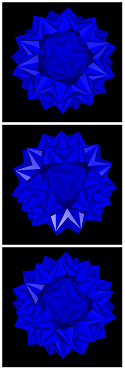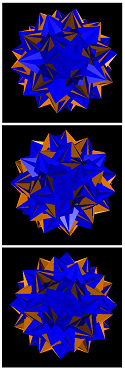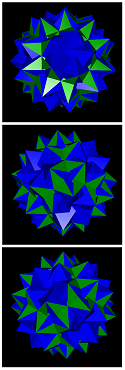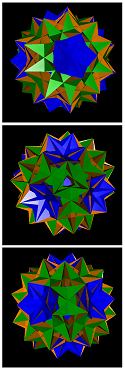Gidrid-facetings
The gidrid (great dirhombicosidodecahedron) contains 24 pentagrams, 40 triangles and 60 squares. It has icosahedral symmetry. The edges of the gidrid can be connected by those 24 pentagrams (first number), 160 triangles (second number) and those 60 squares (third number). Thus, a very big number of new polyhedra arises. The axial 3-fold group exceeds any analysis as it contains 117.800 non-compound facetings. Two figures appear in the icosahedral group. They are the chiral gisdid (great snub dodecicosidodecahedron) and the gidrid. To give a feeling how those skelettons are related to other-symmetrical (ie. octahedral) figures, the 20-octahedra-compound and the 20-thah-compound (thah = tetrahemihexahedron) are shown below too. Note that the octahedron and the thah are the only 3-fold non-compound facetings without pentagrams. Finally in the axial 5-fold group we have 15 antiprismatic polyhedra, 9 antiprismatic-chiral ones, 10 with pyramidal-nonchiral symmetry, 120 with rotational reflection, and 250 with pyramidal-chiral symmetry. It appears that any 5-fold faceting contains all the 24 pentagrams.
symmetry: ike
20-oct-compound |
20-thah-compound |
gisdid |
gidrid |
back
Further gidrid-facetings by R. Klitzing:




